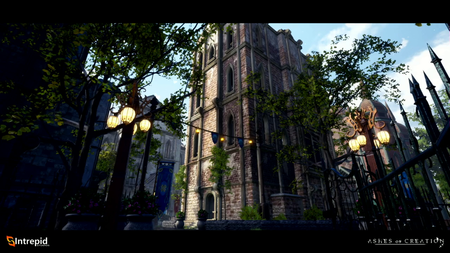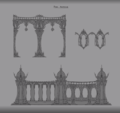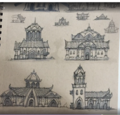Architecture
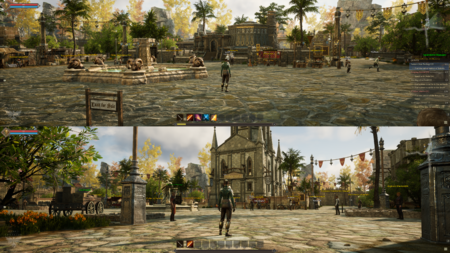
The layout and architecture within a Node’s development area are determined by influential race. For example, a stage 3 Node with the majority of player contribution being Py'rai would have a Py'rai village with Py'rai architecture. Most NPCs would be Py'rai elves, and offer questlines within the Py'rai narrative.[1] – Margaret Krohn
Each player’s contributed experience is flagged with their character race and other identifiers. When a Node advances, the race with the highest experience contribution determines the Node’s style and culture. This style and culture change can happen at every Node Stage. For example, if a Node advances to Level 2 - Encampment Stage and 51% of all experience was earned by Ren’Kai players, the Node will be a Level 2 Ren’Kai Node. If that same Node advances to a Level 3 - Village Stage Node, but the Py'Rai contributed 62% of all the experience earned, then the Node will be a Level 3 Py'Rai Node.[2] – Margaret Krohn
Node layout and style is determined by several factors:[3][4]
- The way that the node system is built is that they can exist across a spread of 18 biomes, but at the same time have to represent the cultural influence of these cultures that are intrinsically a part of a specific biome.[5] – Steven Sharif
- Environment (biome) and location of the node.[5][3][4]
- Nodes will adjust the local topography to fit the aesthetic and mechanical requirements of the node.[6]
- Currently the way that the platform system is set up, is it's capable of adjusting the topography of the node's footprint, regardless of the surrounding terrain. So the reason for that is we want to have flexibility in the presentation of the node's layout and how it is essentially both from an aesthetic standpoint as well as a mechanical standpoint with node sieges- how it's constructed and that construction should have the ability to take on a variance of different types of topography. So it shouldn't be dependent on the surrounding area. Now that's not to say that the surrounding area isn't going to have some influence over. So for example... we're experimenting a little bit with the platform tech and putting up a node up against the side of a mountain or on the edge of a cliff or something that has a beautiful vista. Those are things that we're going to test out obviously as we continue to work on the node tool and how that platform system works, but the idea is to have the node independent of the surrounding terrain.[6] – Steven Sharif
- Some parts are determined by the area it's in. Some parts are determined by the type it is. Some parts are determined by the race it is; and then the rest of it is determined by the mayor.[4] – Jeffrey Bard
- Race that contributed the highest percentage to the node's advancement will alter the racial appearance of its buildings, NPCs, and props.[7][8][3][2][4][9][10]
- All nodes, whether they're associated with a castle or associated with normal node structure, has cultural influences that replicate over to the buildings that are produced and the NPCs that are present.[12] – Steven Sharif
- The rest is determined by the node's mayor.[4]
- It should be possible for a node to complete several building projects within a mayor's one month term in office.[13]
- Q: How long would you say it will take players on average to fill/build up a node completely from wilderness to metropolis?
- A: It's one thing to get a node to a certain level: it's another thing to develop the node; and I can't really give you an on-average expectation, because there's a lot of variables at play. There's how many citizens does the node have attracted to it; what's the type of traffic that the node is attracting to it based on things like its tax rates, or the specialization that it chose to spec into, based on the building types it's chosen to build. All of those things are variables that can affect the quote-unquote "average build-out time" of a particular node. So it's difficult to give you an average when there's so many variables along those lines. But the idea is that if there is a particular project that players are interested in in developing based on the node stage, that they would have the ability to complete several of those projects as within a single term of a mayor; and a term of a mayor is one month.[13] – Steven Sharif
Node buildings
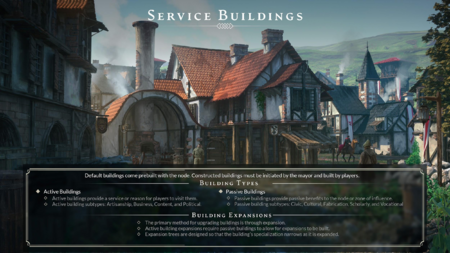
The important thing with the service building system for us is that it's a way to shape your node like a character; and to give you an exclusive niche that you can carve out in the world; or a niche that you fight over. If you go down this weaponsmithing path and you build your node to be this mecca of weaponsmithing and the node three doors down builds it, there's reason for you to conflict over it. They're taking your business. Or maybe you are in a zone and there isn't a weaponsmithing thing anywhere near you, and you do want to start to carve that path for yourself to make your node a place people visit and come to.[15] – Chris Justo
Service buildings within a node are either default buildings that come with the node, or they are constructed buildings, which are initiated by the mayor and built by players.[14][15][16][17][18][19][20] Service buildings are further broken down into two main types:[14][15]
- Active service buildings are service buildings that players directly interact with. These are further broken down into Artisanship, Business, Content, and Political categories.[14][15]
- Passive service buildings provide passive benefits to the node or its zone of influence. These buildings are broken down into Civic, Cultural, Fabrication, Scholarly, and Vocational.[14][15]
- Constructed service buildings are available to every type of node in every location. Where the uniqueness comes in is in some of the default buildings like your node-type building.[21] – Chris Justo
Service buildings are upgraded by expansions, which are unlocked through the placement of passive service buildings.[14][15]
- Building expansions unlock higher tier workstations at the cost of dedicating service building plots.[22][18]
- Node service building expansions specialize the building through a tech tree based on the stage of the node.[23][24]
Service buildings incur a regular maintenance cost of node commodities and gold from the node treasury in order to continue operations.[14][25]
Unique node buildings
Each node type has a unique service building associated with it that can be activated at Village (stage 3) of node advancement.[21] The unique building plays a central role in the progress of civilization for a server.[27]
Freehold buildings
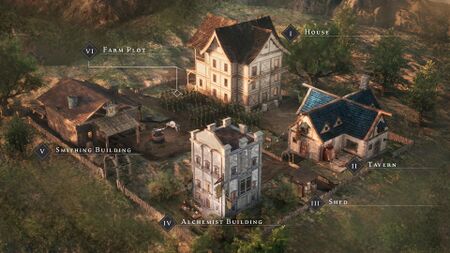
After you build your house, you can build other buildings on your Freehold. Each building needs the blueprint to start the process. If you have a cosmetic skin you want to use on a building, this is used after placing the blueprint. Once this has been placed, the building will be shown in a non-functional, construction state. Players will need to provide the required materials needed to complete the building construction, for each building on their Freehold. No Freehold has room for every possible option, so players will need to choose how to develop their Freehold by choosing to build specific artisan buildings, business buildings, and creating room for livestock and crops.[30]
Freehold buildings that can be placed on a freehold plot serve three main purposes.[30][29][31][32][33]
Freehold buildings require blueprints and materials to construct.[30][35]
- Sheds are present on empty freehold plots to provide storage for materials needed to construct freehold buildings.[36]
- Some freehold buildings have multiple tiers, with different footprint sizes.[29][37]
- Upgrading a tier will not change the size of the building in terms of footprint, but may increase in height.[37]
- Basements in freehold buildings are to be decided.[38]
Freehold taxes are calculated based on the number of permits issued for buildings on a freehold.[30][39][40][41][42]
- Buildings that require permits will have additional upkeep costs.[30]
Freehold building architecture is based on the blueprint for the building.[29][43]
- Freehold skins are applied to blueprints matching the type of building: housing, artisanship, and business.[30][29][44][45][43][46]
- The freehold building blueprints must be obtained in-game first before the cosmetic can be applied.[43][46][45]
- Players are not locked to the racial appearance of a freehold building blueprint.[47]
- The way we look at it is the freehold is your space so we want you to be able to make it look the way you want it to.[43] – Jeffrey Bard
Artistic style
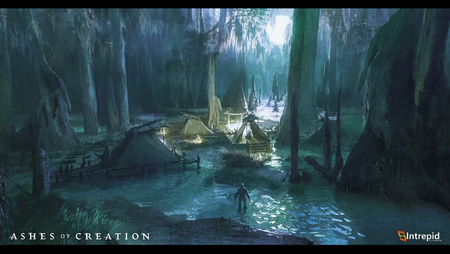
Part of the biome that the Ren'Kai are accustomed to is a more swamp or marsh oriented, so they have these almost stilt-like foundations on some of the assets because they're intended to sit above that marsh.[48] – Steven Sharif
Ashes of Creation will have a higher graphical fidelity than most western games. It will not be too stylized or "cartoony".[49]
- We can push the limits a little bit on the graphical fidelity, especially using Unreal Engine 4... My desire was not to see very cartoony games. I'm not a big fan of highly stylized art.[49] – Steven Sharif
- It's not to say that people can't do steampunk well. I've enjoyed some steampunk stuff. I'm a very high fantasy oriented type of storyteller; and the inspiration for Ashes obviously comes from my pathfinder campaigns that I ran long ago; and those are always set in a high fantasy world. So it just compromises what I believe is the perspective of the storytelling in the environment.[50] – Steven Sharif
- Intrepid Studios does not use AI for art production.[51]
- We do not use AI for production, except in unique internal cases when communicating fast reference material.[51] – Steven Sharif
Artistic influences
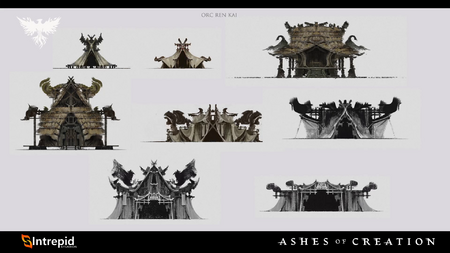
Character races are super important. These are the choices that we make at the onset of our adventure in an MMORPG: what race- not just mechanically aligns with our decisions, if those races have game mechanics behind them from a stat perspective, but visually and culturally and historically: What are these? What do these races represent? So it's important that visually they're distinct. And everyone's seen fantasy games do Elves, so everyone's seen them do Humans, everyone's seen them do Orcs: There's an established expectation almost behind what these traditional fantasy races represent; and there's a risk, because whenever you're creating a new IP or a new story or a new world- a new Universe; a realm in which things don't have to always be the norm, you can take a little bit of creative liberty to redefine some of the aspects of a particular race; and that can be a good thing, because it's something that is new to players. It's something that is unique to the realm that we're building- the surroundings that you have. So what we wanted to do was push a little bit more on the unique side of what the Py'rai would look like from a visual perspective.[53] – Steven Sharif
- Aelean architecture has a French medieval influence.[54]
- Dünir have a Nordic cultural influence.[55]
- Empyreans have a Greco-Roman imperialistic feeling.[56]
- The Kaelar have a European influence.[57]
- The Niküa have a Polynesian influence.[58][56]
- The Py'Rai have a Navajo Native American influence.[56] Py'Rai architecture has a woodland inspiration.[59][60]
- Pyrian architecture has a Greco-Roman influence.[61]
- Ren'Kai architecture has an Asian influence.[52]
- The Vaelune have a Middle Eastern influence.[62]
- The Vek have a Mesoamerican influence.[62]
- You will see in the different races that are available from a player character standpoint a lot of different influences that reflect many cultures in the world: Not just European, not just Africa, not Mesoamerican. These cultures are going to be present in many of the races.[63] – Steven Sharif
- The idea is just to find a base component in the real world as a starting point and then to begin to fantasize.[54] – Steven Sharif
Gallery
See also
References
- ↑ Blog - Know Your Nodes - The Basics.
- ↑ 2.0 2.1 2.2 Blog - Know Your Nodes - Advance and Destroy.
- ↑ 3.0 3.1 3.2 Livestream, October 30, 2020 (39:17).
- ↑ 4.0 4.1 4.2 4.3 4.4 4.5 Livestream, September 27, 2018 (53:06).
- ↑ 5.0 5.1 Livestream, February 25, 2022 (41:00).
- ↑ 6.0 6.1 Livestream, February 26, 2021 (1:12:18).
- ↑ Livestream, March 31, 2022 (4:57).
- ↑ Podcast, April 11, 2021 (29:47).
- ↑ Interview, May 11, 2018 (54:34).
- ↑ Livestream, May 26, 2017 (21:23).
- ↑ Podcast, April 11, 2021 (23:36).
- ↑ 12.0 12.1 Interview, May 11, 2018 (47:27).
- ↑ 13.0 13.1 Livestream, July 29, 2022 (1:13:09).
- ↑ 14.0 14.1 14.2 14.3 14.4 14.5 14.6 Blog: Development Update with Village Node.
- ↑ 15.0 15.1 15.2 15.3 15.4 15.5 15.6 Livestream, August 31, 2023 (50:25).
- ↑ Video, August 31, 2023 (2:59).
- ↑ Interview, July 9, 2023 (1:32:45).
- ↑ 18.0 18.1 Livestream, May 19, 2017 (33:57).
- ↑ Livestream, January 20, 2018 (38:17).
- ↑ Livestream, 2018-04-8 (PM) (51:49).
- ↑ 21.0 21.1 Livestream, August 31, 2023 (56:18).
- ↑ Livestream, August 31, 2023 (52:56).
- ↑ Video, August 31, 2023 (34:37).
- ↑ Livestream, March 31, 2022 (1:13:00).
- ↑ Livestream, August 31, 2023 (57:23).
- ↑ Livestream, September 1, 2018 (36:28).
- ↑ Know Your Nodes: Economic Node Type.
- ↑ Livestream, June 30, 2023 (12:11).
- ↑ 29.0 29.1 29.2 29.3 29.4 29.5 Development Update with Freehold Preview.
- ↑ 30.0 30.1 30.2 30.3 30.4 30.5 Blog: Exploring the Boundless Opportunities of Freeholds.
- ↑ 31.0 31.1 31.2 Livestream, April 7, 2023 (31:49).
- ↑ 32.0 32.1 Node series part II – the Metropolis.
- ↑ Livestream, May 24, 2017 (9:58).
- ↑ Video, June 30, 2023 (15:34).
- ↑

- ↑ Livestream, June 30, 2023 (18:45).
- ↑ 37.0 37.1 Interview, July 8, 2020 (45:23).
- ↑ Livestream, June 28, 2019 (1:09:22).
- ↑

- ↑ Interview, July 9, 2023 (54:46).
- ↑ Livestream, June 30, 2023 (1:45:22).
- ↑

- ↑ 43.0 43.1 43.2 43.3 Livestream, August 28, 2020 (2:14:06).
- ↑ Livestream, June 30, 2023 (22:05).
- ↑ 45.0 45.1 Livestream, November 30, 2020 (57:50).
- ↑ 46.0 46.1

- ↑ Livestream, May 26, 2017 (44:11).
- ↑ 48.0 48.1 Livestream, February 25, 2022 (46:17).
- ↑ 49.0 49.1 Interview, October 20, 2018 (2:17:43).
- ↑ 50.0 50.1 Livestream, March 31, 2023 (1:17:42).
- ↑ 51.0 51.1

- ↑ 52.0 52.1 Livestream, October 31, 2019 (40:27).
- ↑ Livestream, February 25, 2022 (49:42).
- ↑ 54.0 54.1 Interview, October 20, 2018 (3:47:17).
- ↑

- ↑ 56.0 56.1 56.2 Interview, May 11, 2018 (1:03:21).
- ↑ Podcast, May 11, 2018 (31:35).
- ↑ Livestream, September 30, 2022 (1:08:24).
- ↑ Livestream, February 25, 2022 (44:28).
- ↑

- ↑ Livestream, October 16, 2017 (15:58).
- ↑ 62.0 62.1 Podcast, May 11, 2018 (31:35).
- ↑ Interview, May 11, 2018 (1:04:27).
